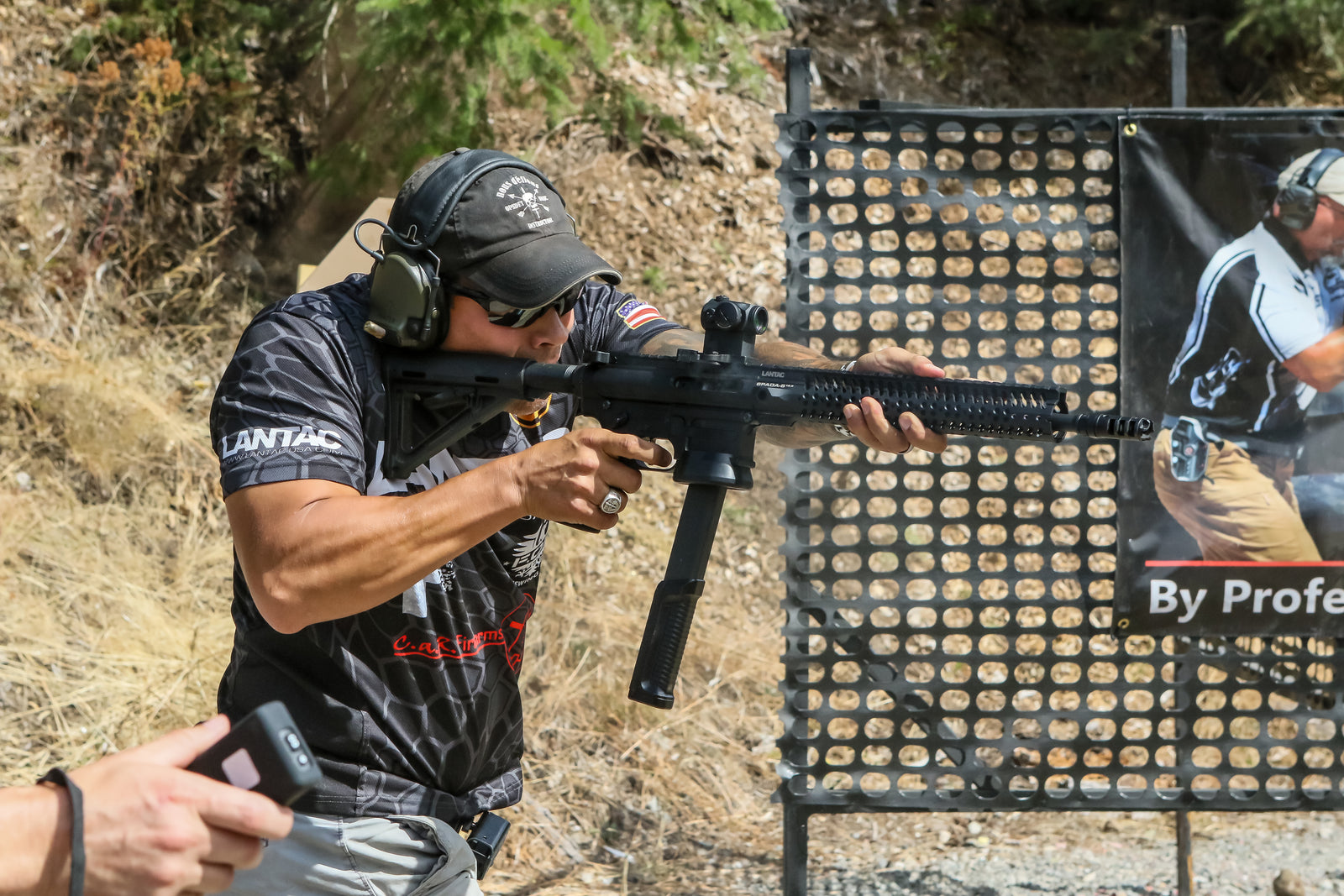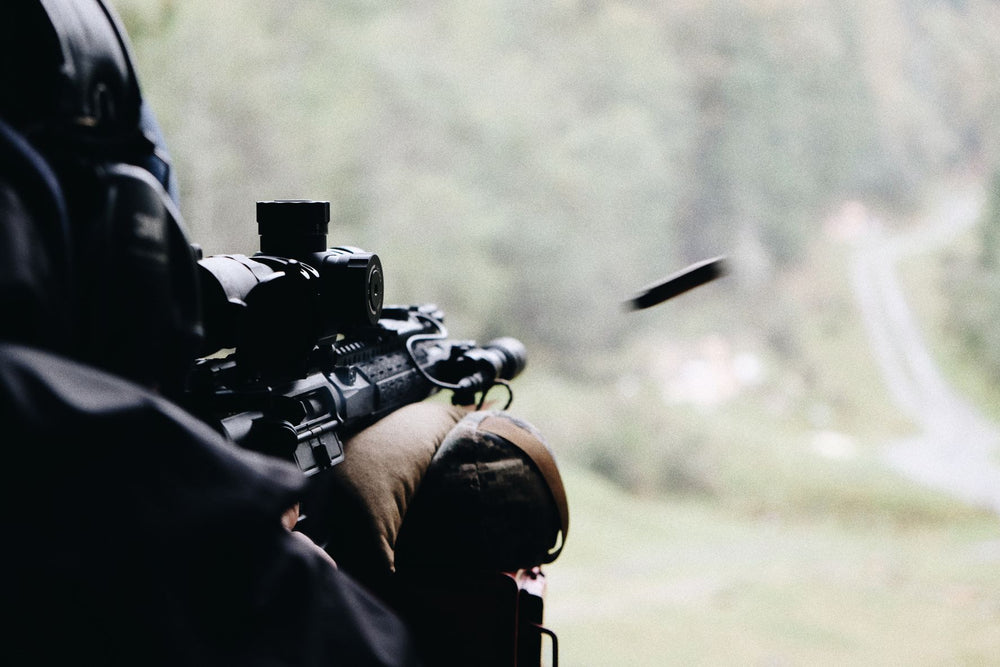Mental Management For Life

Mental Management For life
My Army unit’s Sports Psychologist called me and asked for a personal favor. Seeing how her job entailed training Green Berets to make pivotal mental performance improvements under stress, I felt this was an opportunity for me to give back for all the help she’s given to me and 1st Special Forces Group. She said she had a friend, an Army Ranger officer, who had just been selected to attend the Operator Training Course (OTC) for the world’s most elite military unit: Delta Force. Apparently, I was highly recommended as a rifle and pistol fundamentals instructor. I thought to myself, “What would this guy want from me, especially since he’ll be trained at OTC?”
This Ranger officer, who has done more strategic planning and commanding for Ranger missions, rather than shooting the enemy in the face alongside his men, was quite a bit rusty when it came to firearms fundamentals. He wanted a pre-OTC 1-on-1 instructional to prepare him when it came to the flat-range and to build more confidence going in. Key mental preparation for the challenges ahead. After my crash course pistol fundamentals class, I took his 7-yard, 5-round head-sized shot group to a sub-1” square paste being cleanly shot out in a matter of hours. He wasn’t a bad shooter by any means, but I definitely helped improve his performance and build his confidence. That’s all he wanted going into OTC. “This guy knows how to manage his mental obstacles. He’ll be just fine.”, I thought to myself. As a thank you for volunteering my personal time, he gifted me a book, ‘With Winning In Mind’ by Lanny Bassham. A book on mastering the mental management systems that ultimately determine the outcomes of performance challenges and overall successes, particularly with shooting.
Bassham was a 1976 Olympic gold medalist and four-time world champion rifle shooter. He mastered this mental regimen and taught how his methodology could be applied, not only in competitive sports, but in business and government as well. His clientele consists of world-class athletes, corporation CEOs, entrepreneurs, federal law enforcement, and even Special Operations Forces (SOF). A fascinating story about him was when he was stationed at a non-shooting assignment while serving in the Army from 1976-1978, Bassham only shot a total of six days in those two years: Three days at the national match in 1977 and three days at the national match the following year, where he won both national titles. He never fired a single live-fire shot for training during that time, but instead had mental training sessions of visualizing himself shooting (or rehearsing) on the range while he physically dry-fired his rifle. Proof of how powerful visualizing success can be.
I grew up wrestling in middle and high school where lifelong lessons of physical hardship, mental resiliency, goal setting, overcoming performance anxiety, handling defeat and achievement through competition were initially practiced. Though, I fell short of my realistic goal of making it to the championship finals match my senior year (I instead took 5th in WA State, still a great performance) I took these valuable lessons and applied them into my adulthood. In the fall of 2009, I donned the coveted Green Beret. The issued headgear of the US Army Special Forces. A lifelong goal of mine I’ve finally achieved. Initially, I was scared to even tryout for Special Forces selection. No one wants to be told “You’re not what we’re looking for.” Or “You’re not good enough.” That fear of failure was the first mental obstacle in my journey to earning the Green Beret and becoming a Special Forces soldier. If you let yourself be defeated by your own insecurities or lack of confidence, you’ll never achieve anything. You’ll never appreciate the journey of a challenge. You’ll never understand what you’re truly capable of. As Henry Ford states, “whether you think you can, or think you can’t- You’re right.”
After spending five-and-half years on an Operational Detachment-Alpha (ODA) or a Special Forces team, I thought the 38 cumulative months of combat in Iraq and Afghanistan over four combat deployments and years of range time would have made me as good a shooter as Pat McNamara or Instructor Zero (popular gun influencers of the time). For fun, I regularly challenged their time and accuracy standards and met or even beat them whenever I ran a range for my team. Among my Special Forces Company of 80 Green Berets, I was a top shooter. In the spring of 2016, I was assigned to the Special Forces Advanced Skills Company (SFASC) as a firearms and tactics instructor on the Special Forces Advanced Urban Combat Course (SFAUC) committee. A fitting position for a high drive elite soldier with a passion for shooting.
Although I had the confidence and experience to teach rifle/pistol fundamentals and Close-Quarters Battle (CQB) to deploying Green Berets, I wasn’t yet certified to do so. I was sent to Fort Bragg, NC to attend a 9-week CQB course, Special Forces Advanced Reconnaissance Target Analysis and Exploitation Techniques Course (SFARTAEC). This course is only one of the two certifying CQB courses in the Army (the other being OTC), both of which are validated by Delta because of interop ability between these tier 1 and tier 2 units. It was challenging to say the least. With an attrition rate of 30%-50%, depending on the class, I had some serious mental preparation ahead of me.
In Bassham’s book, he wrote, “Mental management is the process of maximizing the probability of having a consistent mental performance, under pressure, on demand.” Up until this point in my life, I had unknowingly practiced this process through trial and error. But it took time to hone this skill of overall mental management. Going into SFARTAETC, I was aware of these attrition rates, but because of my experience overcoming performance challenges when it counted, the mental preparation became much easier the more it was time for me to perform. I wasn’t worried about passing the entire course because I was more focused on taking it one day at a time. Even cutting that single day into focusing on the task in front of me before anything else. For example: In the first three weeks of SFARTAETC there were daily warm-ups and graded shooting drills that cumulate into a partial score that ultimately would earn your way into the shoot-house phases.
One of these drills consisted of shooting a Glock 19 with 10-rounds at a standard Army 25-meter bullseye target with 5–10-point scoring rings, no time limit and without any equipment on with a minimum score of 70 points out of 100. Easy right? It was actually one of the most difficult graded drills and would drop 15% of the class. But it demonstrated that a student could truly master all the pistol fundamentals: Stance, breathing, grip, sight alignment, sight picture, trigger manipulation, follow through, and recovery. I visualized executing every single fundamental and hitting inside the 10-ring before I even shot. Eventually, it became a subconscious act because of continuous repetition. This process worked because I averaged around 88. You would be really good if you shot over 90. The highest I’ve ever seen was 96. There were times that I had a bad morning and shot below 70 for whatever reason. Then I remembered what Bassham wrote, “I do not reinforce bad shots by remembering them.” Take your hit on the chin and focus on the next task because your past performance doesn’t matter when you have a new task directly in front of you. It’s fine to make mistakes, just not the same ones consistently. Fortunately, bad performance was factored into the scores as an average so there was some room for error.
On top of the individual shooting performance expectations needed to prove you were skilled enough to safely shoot live ammunition within inches of a non-threat or a fellow assaulter while running and gunning at night and under night-vision, after roping in from a helicopter to explosively blow the door off the roof access of a building, I had the additional responsibility of being the acting-Troop Sergeant Major. A leadership position overseeing 25 assaulters, mostly involved with planning, and directing targeted assaults, usually under time constraints with limited intelligence. Stress on top of stress. But I did it well. After graduation, I came out of SFARTAETC thinking I was John Wick. But I soon would have an entire plate of humble pie smashed in my face.
One of my fellow SFAUC committee instructors, Jeramiah Futch, was a former member of the 1st Special Forces Group Crisis Reaction Force Company (CRF-the tier 2 version of Delta Force) and a United State Practical Shooting Association (USPSA- A worldwide sport shooting league) A-classified competitor. He would eventually place 15th at the 2018 multi-gun nationals for tactical optics division. Jeramiah and I would regularly have friendly banter and shooting competitions whenever we ran committee ranges for instructor training. He was naturally better at pistols than me, but we were always close when it came to the MK18 rifle. He finally challenged me to a local sanctioned USPSA competition. Of course, I took him up because I thought I was John Wick. At the time I had recently built a Pistol Caliber Carbine (PCC- An AR that shoots 9mm) rifle and it was a new division to compete in at the time. I was excited to see where I stood among others outside of the Special Forces community. When I arrived at Paul Bunyan Range in Puyallup WA, I had about twelve competitors in my division. Most were 40-years-plus in age. Additionally, there was a 15-year-old girl, a man who was easily seventy, and a guy so fat, I didn’t know they made pistol belts long enough for him to wear, let alone how he could even reach his magazines. I thought I was going to smoke these guys and take the Win.
*BEEP* Off went the fat man, moving so fast (for a fat man) I was shocked he didn’t snap an ankle when he stopped to shoot or had a heart attack after the stage was complete. “16.25 seconds!.” Wow, that was actually pretty quick. “Two alpha! Two alpha! Alpha Charlie…Hit factor: 6.35,” the Range Officer announced. Hit factor is the points earned divided by the time on a given stage. The higher, the better. His hit factor was actually impressive, for a fat man. But I’m next and will smoke this walking medical liability. *BEEP* *PEW, PEW, (miss) PEW, PEW, PEW* “15.88 seconds!” “WHAT?! I only beat his time by .37 seconds?!” I thought to myself. “Two alpha, Charlie Delta, MIKE (miss)… Hit factor 4.21.” “What the actual f*ck?! How am I shooting so crappy?” I thought. By the end of the 5-stage competition, deceivingly athletic fat man, 15-year-old girl, and several middle aged, average shaped men beat me. I placed seventh out of twelve. Just an average shooter among civilians. I was completely shocked and my ego a bit bruised.
Jeramiah pulled me aside, shook his head and laughed, in private of course. He knew this would be my outcome and I totally deserved it. I was cocky and unprepared. But I am so glad it happened because it made me realize I wasn’t as good as I thought and that I had some serious work to do. I was immediately hooked and determined to be good at this sport. I saw it as a direct correlation to tactical shooting because the rifle and pistol fundamentals are the same. The sport aspect offered an environment of performing under stress, nothing like being shot at, but simulating stress, nonetheless. This could only make me a better shooter and an instructor. Jeramiah, being the excellent instructor that he is on a military range as well as a civilian sport range, took me under his wing as my mentor and taught me the USPSA ruleset and how to stage plan for competition. Additionally, I also had to mentally reset myself by setting realistic short-term and long-term goals. This gave me direction and purpose in my path to achievement.
In USPSA, there are classifications that identify a shooter’s skill and ability, but also separates these shooters to compete with only those within their classification. Similar to Brazilian Jiu Jitsu belt rank by precedence (white, blue, purple, brown and black), USPSA classification by precedence is D, C, B, A, Master, and Grandmaster. These classifications can be earned by shooting a classifier stage at a competition and scoring an average over your best six classifier stages. Each classifier stage score is determined by who shot it best… In the entire world. If you shot within 5% of the points earned by the best shooter who shot the same stage, you’ve earned a Grandmaster score. No easy feat. Within 10%, Master. Within 20%, A-class, and so on. That title was obviously a goal of mine, but I had to start small. First, beat the fat man.
After a few weeks, I was consistently beating the fat man. Then the 15-year-old girl. Then I started placing top three. After six months, I won my first local competition. After a year, I was traveling farther to shoot and seek out new competition. At that point, I was shooting within 5-10% of the winner and beating Master and Grandmaster PCC shooters regularly. I eventually earned a Master classification which I carried for almost two years. In fall of 2019 while I was attending the Special Forces Sniper Course (SFSC) on Fort Bragg NC, I finally earned the USPSA PCC Grandmaster classification. While I was shooting on the Army’s time during the week, I took the opportunity to take a mental break from shooting precision long range for work… By shooting short range competition on the weekends for fun. Crazy, I know. I used these short-term goals to define personal success. Initially, I wasn’t trying to win. I was just looking to beat a certain individual, then I raised my goal from there. This gave me direction and built my confidence over time as my skills were developing and before I realized, I was earning higher classifications and placing well or winning competitions. This only validated my self-perceived skill.

In the winter of 2020, I was operationally deployed to South Korea for a six-month tour, right in the beginning stages of the COVID-19 pandemic. So, as you would remember, it was basically world lockdown. Getting to the range was nearly impossible and required high ranking commanding officer approval. So, I reverted to the mental visualization training similar to Lanny Bassham’s non-shooting assignment. I built mock-stages with paper targets inside our team’s equipment loading bay and physically ran it with a dry-rifle as if I was actually shooting it live. After the buzzer *BEEP*, I ran to my first ‘shooting’ position, I placed my rifle on fire, pulled the trigger, and in my mind, *PEW PEWS* launched those 9mm projectiles. I visualized those imaginary rounds hitting the A-zones on the target. After my last shot of my pretend-shooting competition, I slapped my buzzer to actually record my time. Then I ‘shot’ the stage again to improve my time. I held myself accountable when I had missteps in my footwork and ‘reshot’ my stage until it was perfect in my mind. I did this visual training (or rehearsal) for an hour, twice a week for six-months because I had my eyes set on winning the 2020 USPSA WA State Championship title. This method of reinforcement is exactly what Bassham speaks about, “The more we think about, talk about and write about something happening, we improve the probability of that thing happening.”
After my redeployment back home in the spring of 2020, I only had a couple months to prepare for the state championship match. My first competition back from South Korea, and the first I’ve shot my PCC in eight months gave me quite a bit of performance anxiety. But as soon as that buzzer went off, I completely forgot about anything negative and focused on getting my double-alpha hits. By the end of that first competition, I had dominated the standings by taking the win. My months of mental and visual training had paid off, as if I had been shooting live the entire time. Months later, I won the USPSA WA State PCC Championship title. Up to this point in my competitive shooting career, the act of physically performing on demand was purely credited to being mentally prepared well beforehand.

In a Recoil Magazine interview with Team Sig’s multi-time national and world champion shooter, Dan Horner, Recoil asks, “…So the competition reaffirms your expertise?” Horner Replies, “It validates everything. It validates your equipment, it validates your training, it validates your mindset, and it validates your status. If you don’t keep score, it doesn’t matter. Everybody can talk about it, and you hear all the time: ‘I’m pretty good with a gun.’ Well, quantify that. ‘Pretty good’ means nothing.” I couldn’t agree more with his statement. As John Carughi eloquently preaches, “Get out there and BANG!” See where you actually stand with others.
Mental management has worked for me in so many aspects of my life. I’ve applied it as a child, through my wrestling coach’s careful guidance in early competition, throughout my profession as an Army Special Forces soldier, and even to my recreational interests of sport shooting and competitive Brazilian Jiu Jitsu. It’s a life skill that’s been proven to work. Not only for me, but for so many others. You don’t have to be an athlete, or a sport shooter to set goals to work towards. These skills could be applied to taking a leap and finally applying to that job you’ve always wanted, or that new truck you’ve drooled over, or the girl you’ve wanted to ask out. As I transition into military retirement after 20 years of service to this great nation, you’d be absolutely correct to guess that I will be setting new goals to work towards in my next professional endeavor as a law enforcement officer. Living life without direction leaves one lost. Set a goal, a challenging one, then work towards it. Worst case, you’ll still end up further than when you started. In other words, it’s better to aim for the moon and miss, than to aim for a pile of sh*t and hit it.
By: Jon Porter
Youtube: WARRIOR MINDSET @SNAKEEATER1776





A great read. With an honest perspective. Thank you for this. Many people will benefit. Post more!
Good article! I’m going to use your advice about mental imagery with my granddaughter in gymnastics.
Dejar un comentario